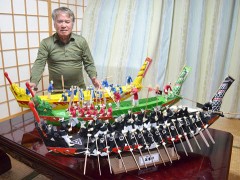Dragon boat models made using 45,000 toothpicks

On April 16, at his house in Itoman. Genei Agena made models of Naha Harii dragon boats.
April 23, 2013 Ryukyu Shimpo
With the Naha Harii or dragon boat races being held from May 3 to 5, Genei Agena, a 75-year-old resident of Itoman made three models of dragon boats. The models, which took two years to complete, were presented to the Naha Municipal Office, where they were exhibited from April 23 to 30.
Each model boat was made using about 15,000 toothpicks. Agena said, “A lot of hard work went into making these. I hope that many people see them. I’m pleased that I could do something to help promote the Naha Harii.” The model dragon boat is about 110 centimeters long.
The green boat, Naha, and the yellow boat, Kume, have oarsmen on board preparing for a race and the black boat, Tomari, shows the oarsmen actually paddling. The base is made of toothpicks on which he used a chisel and plane to craft them into shape. The dragon decorations on the prow and stern are woodcarvings. The figures are made from toothpicks and paper clay and dressed with hand-sewn kimono. The oars are made from disposable wooden chopsticks.
Agena is from Matsuyama in Naha. Influenced by his late father Kokko, who was a Ryukyu lacquer-work craftsman, he has been making sculptures of one kind or another since he was a child. After he graduated Naha High School, Agena worked in the photo-engraving business in Tokyo before returning to Okinawa where he worked in Matsuyama. Agena developed an interest in Naha’s festivals because his father handled hatagashira, the large flagpoles used in the Naha Tug-of-War.
He is particularly attracted to the Harii dragon boat events and every year he goes to the festival. Agena always gets excited when the main event of the festival, the Ugan Barii, starts. For these reasons, he has long dreamed of making models of Naha Harii and when he retired he spent much of his time working on these models, finishing them in two years.
While he pleased with the result of his efforts, saying, “They worked out really well if I say so myself.” He went on to say, “I couldn’t make these again though. It was really hard work.” But at the same time, he hinted at his next project, saying, “But making a sabani might be easier.”
(English translation by T&CT, Lima Tokumori and Mark Ealey)
Previous Article:People enjoy digging clams at Henoko
Next Article:Villagers seek to use Okinawa rails to revitalize community
[Similar Articles]
- Noro prays for Naha dragon boat race at Tomigusuku Castle ruins
- Naha Harii dragon boat race starts under rainy skies
- East team wins Ojima Island’s dragon boat race
- Naha Harii dragon boat race
- Ryukyu Dynasty banquet reenacted with traditional dragon boats on the Ryutan Pond
 Webcam(Kokusai Street)
Webcam(Kokusai Street)


